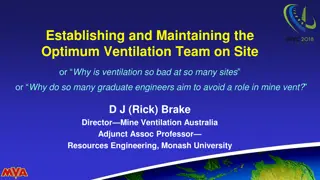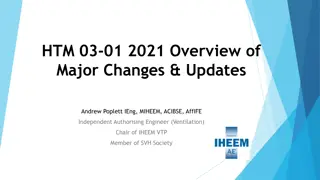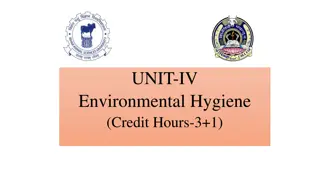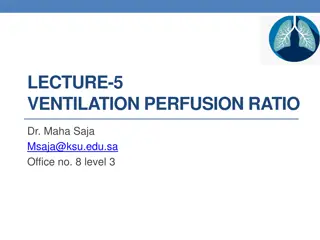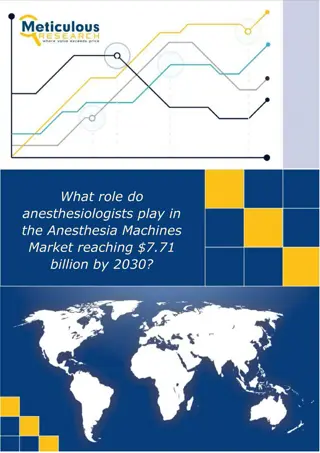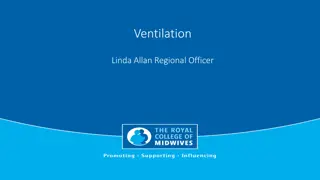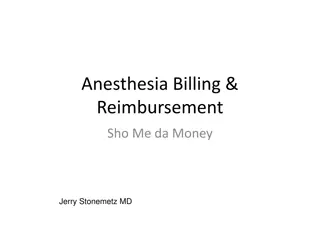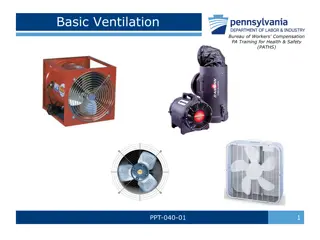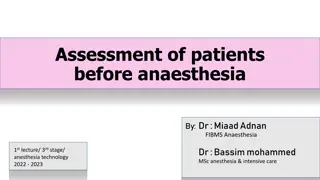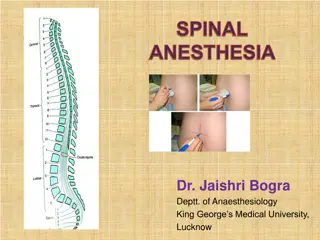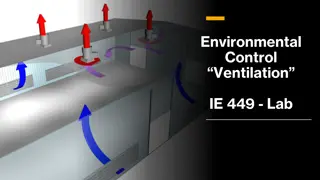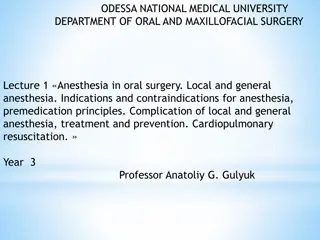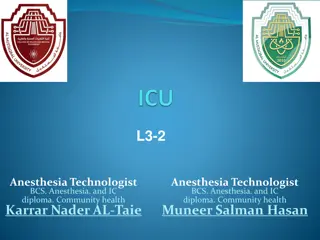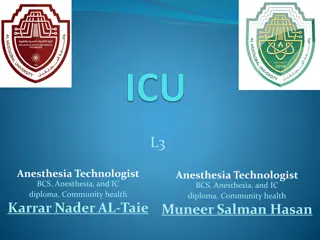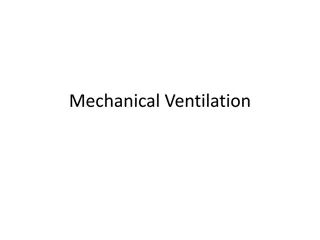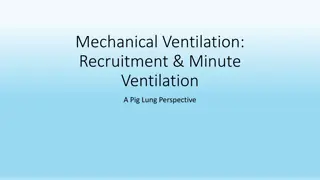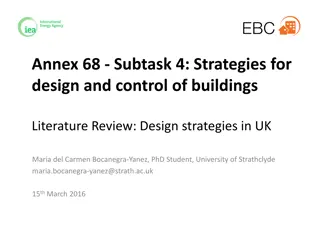Anesthesia Technologist: Ventilation Modes Overview
The content covers different ventilation modes used in anesthesia, such as Pressure-controlled ventilation and Pressure-support ventilation. It discusses the principles, advantages, and disadvantages of each mode, highlighting key considerations for effective ventilation management.
Download Presentation

Please find below an Image/Link to download the presentation.
The content on the website is provided AS IS for your information and personal use only. It may not be sold, licensed, or shared on other websites without obtaining consent from the author.If you encounter any issues during the download, it is possible that the publisher has removed the file from their server.
You are allowed to download the files provided on this website for personal or commercial use, subject to the condition that they are used lawfully. All files are the property of their respective owners.
The content on the website is provided AS IS for your information and personal use only. It may not be sold, licensed, or shared on other websites without obtaining consent from the author.
E N D
Presentation Transcript
L3-3 Anesthesia Technologist BCS. Anesthesia. and IC diploma. Community health Karrar Nader AL-Taie Anesthesia Technologist BCS. Anesthesia. and IC diploma. Community health Muneer Salman Hasan
Artificial Ventilation Part 3
Pressure mode pressure is consistent with these modes, Volume is not inspiration is terminated when a specific airway pressure has been reached. inspiration stops when the preset inspiratory pressure is achieved pressure mode delivers a selected gas pressure to the patient early in inspiration, and sustains the pressure throughout the inspiratory phase.
Pressure modes 1-Pressure-controlled ventilation (PCV) 2- Pressure-support ventilation (PSV) 3- Invasive Continuous positive airway pressure (CPAP) 4- Noninvasive bi-level positive airway pressure ventilation (BiPAP) 5- High-frequency oscillatory ventilation (HFOV) 6-Airway pressure release ventilation (APRV)
1-Pressure-controlled ventilation (PCV) the breathing gas flows under constant pressure into the lungs during the selected inspiratory time. Normal peak inspiratory pressure (PIP) is 25-30 cm H2O. (PIP) should be kept below 20 to 25 cm H2O whenever positive-pressure ventilation is required The flow is highest at the beginning of inspiration (i.e. when the volume is lowest in the lungs). Tidal volume varies with compliance and airway resistance and must be closely monitored. PIP . I:E ratio/ Ti . RR must be selected. Sedation and the use of neuromuscular blocking agents are frequently indicated, because any patient ventilator asynchrony usually results in profound drops in the SaO2.
Advantages 1-Tidal volume variable with constant peak airway pressure 2-Full ventilatory support 3- Decreased mean airway pressure 4- Control frequency Disadvantages 1- Requires sedation or paralysis 2- Ventilation does not change in response to clinical changing
2- Pressure-support ventilation (PSV) the patient breathes spontaneously while the ventilator applies a predetermined amount of positive pressure to the airways upon inspiration. Pressure support ventilation may be combined with SIMV or used alone for a spontaneously breathing patient. In PSV mode, the inspired tidal volume and respiratory rate must be monitored closely to detect changes in lung compliance It is a mode used primarily for weaning from mechanical ventilation.
Use PCV mode 1-ventilation of neonates 2- most complex ventilatory challenges, including severe acute respiratory distress syndrome (ARDS) 3- extremes of airflow obstruction (COPD) 4- difficult to wean patient.
Advantages of PSV 1-Avoids patient-ventilator asynchrony 2-Patient comfortable-having full control over their ventilatory pattern and minute ventilation 3-Avoids breath stacking and auto PEEP Disadvantages 1-Spontaneous mode -can't be used in heavily sedated, paralyzed or comatose patients 2- Respiratory muscle fatigue can develop if pressure support is set too low
3-Invasive CPAP Constant positive airway pressure during spontaneous breathing CPAP allows to observe the ability of the patient to breathe spontaneously while still on the ventilator. CPAP can be used for intubated and nonintubated patients. It may be used as a weaning mode
4- Noninvasive bi-level positive airway pressure ventilation (BiPAP) BiPAP is a noninvasive form of mechanical ventilation provided by means of a nasal mask or nasal prongs, or a full-face mask. The system allows the clinician to select two levels of positive-pressure support: -An inspiratory pressure support level (referred to as IPAP) -An expiratory pressure called EPAP (PEEP/CPAP level).
Weaning: the term weaning is used to describe the gradual process of decreasing ventilator support. Methods of weaning: 1- T-piece trial, 2- Continuous Positive Airway Pressure (CPAP) weaning, 3- Synchronized Intermittent Mandatory Ventilation (SIMV) weaning, 4-Pressure Support Ventilation (PSV) weaning
T-piece trial: It consists of removing the patient from the ventilator and having him / her breathe spontaneously on a T-tube connected to oxygen source. During T-piece weaning, periods of ventilator support are alternated with spontaneous breathing. The goal is to progressively increase the time spent off the ventilator
SIMV weaning SIMV is the most common method of weaning. It consists of gradually decreasing the number of breathsdelivered by the ventilator to allow the patient to increase number of spontaneous breaths
CPAP weaning: When placed on CPAP, the patient does all the work of breathing without the aid of a back up rate or tidal volume. No mandatory breaths are delivered in this mode . All ventilation is spontaneously initiated by the patient. Weaning by gradual decrease in pressure value
PSV weaning: level of pressure support is gradually decreased based on the patient maintaining an adequate tidal volume (8 to 12 mL/kg) and a respiratory rate of less than 25 breaths/minute. PSV weaning is indicated for: - - Difficult to wean patients - Small spontaneous tidal volume.
Weaning readiness criteria: 1-Awake and alert o Hemodynamically stable, 2- Arterial blood gases (ABGs) normalized or at patient s baseline - PaCO2 acceptable - PH of 7.35 7.45 - PaO2 > 60 mm Hg , - SaO2 >92% - FIO2 40% o 3- (PEEP) 5 cm H2O 4- F /RR< 25 / minute 5- Vt 5 ml / kg 6- VE 5- 10 L/m (f x Vt) 7- VC > 10- 15 ml / kg 8- Chest x-ray reviewed for correctable factors; treated as indicated, 9- Major electrolytes within normal range, 10- Hematocrit >25%, 11- Core temperature >36 C and
Signs of weaning intolerance: 1-Diaphoresis 2-Dyspnea & Labored respiratory pattern 3- Increased anxiety, Restlessness, Decrease in level of consciousness 4- Dysrhythmia ,Increase or decrease in heart rate of > 20 beats /min. 5-Increase or decrease in blood pressure of > 20 mm Hg 6-RR greater than 35 breaths/minute 7-Vt 5 mL/kg, ME< 5 L/Min SPO2 <90%, PaO2 < 60 mmHg, PH of < 7.35. Increase in PaCO2



